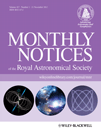Statistical and systematic errors in redshift-space distortion measurements from large surveys
ABSTRACT
We investigate the impact of statistical and systematic errors on measurements of linear redshift-space distortions (RSD) in future cosmological surveys by analysing large catalogues of dark matter haloes from the baryonic acoustic oscillation simulations at the Institute for Computational Cosmology. These allow us to estimate the dependence of errors on typical survey properties, as volume, galaxy density and mass (i.e. bias factor) of the adopted tracer. We find that measures of the specific growth rate β = f/b using the Hamilton/Kaiser harmonic expansion of the redshift-space correlation function ξ(rp, π) on scales larger than 3 h−1 Mpc are typically underestimated by up to 10 per cent for galaxy-sized haloes. This is significantly larger than the corresponding statistical errors, which amount to a few per cent, indicating the importance of non-linear improvements to the Kaiser model, to obtain accurate measurements of the growth rate. The systematic error shows a diminishing trend with increasing bias value (i.e. mass) of the haloes considered. We compare the amplitude and trends of statistical errors as a function of survey parameters to predictions obtained with the Fisher information matrix technique. This is what is usually adopted to produce RSD forecasts, based on the Feldman–Kaiser–Peacock prescription for the errors on the power spectrum. We show that this produces parameter errors fairly similar to the standard deviations from the halo catalogues, provided it is applied to strictly linear scales in Fourier space (k<0.2 h Mpc−1). Finally, we combine our measurements to define and calibrate an accurate scaling formula for the relative error on β as a function of the same parameters, which closely matches the simulation results in all explored regimes. This provides a handy and plausibly more realistic alternative to the Fisher matrix approach, to quickly and accurately predict statistical errors on RSD expected from future surveys.




